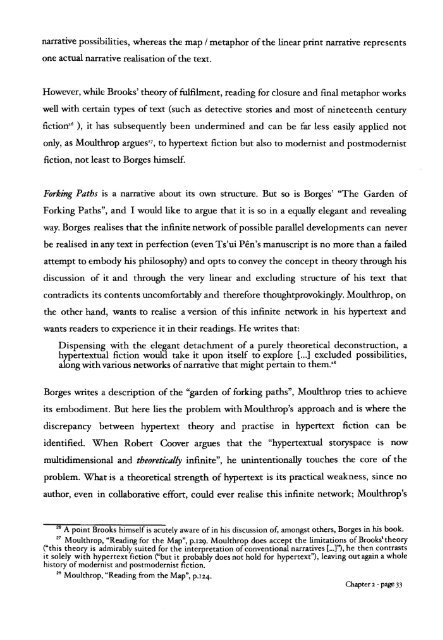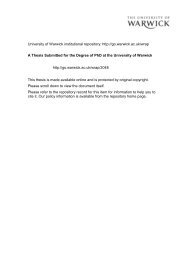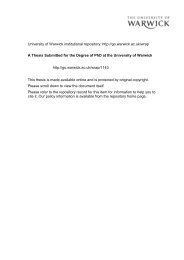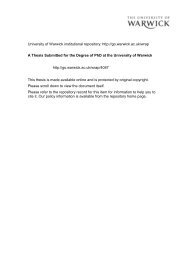From Page to Screen - WRAP: Warwick Research Archive Portal ...
From Page to Screen - WRAP: Warwick Research Archive Portal ...
From Page to Screen - WRAP: Warwick Research Archive Portal ...
You also want an ePaper? Increase the reach of your titles
YUMPU automatically turns print PDFs into web optimized ePapers that Google loves.
narrative possibilities, whereas the map / metaphor ofthe linear print narrative represents<br />
one actual narrative realisation ofthe text.<br />
However, while Brooks' theory offulfilment, reading for closure and final metaphor works<br />
well with certain types of text (such as detective s<strong>to</strong>ries and most of nineteenth century<br />
fiction" ), it has subsequently been undermined and can be far less easily applied not<br />
only, as Moulthrop argues", <strong>to</strong> hypertext fiction but also <strong>to</strong> modernist and postmodemist<br />
fiction, not least <strong>to</strong> Borges himself.<br />
Forking Paths is a narrative about its own structure. But so is Borges' "The Garden of<br />
Forking Paths", and I would like <strong>to</strong> argue that it is so in a equally elegant and revealing<br />
way. Borges realises that the infinite network ofpossible parallel developments can never<br />
be realised in any text in perfection (even Ts'ui Pen's manuscript is no more than a failed<br />
attempt <strong>to</strong> embody his philosophy) and opts <strong>to</strong> convey the concept in theory through his<br />
discussion of it and through the very linear and excluding structure of his text that<br />
contradicts its contents uncomfortably and therefore thoughtprovokingly. Moulthrop, on<br />
the other hand, wants <strong>to</strong> realise a version of this infinite network in his hypertext and<br />
wants readers <strong>to</strong> experience it in their readings. He writes that:<br />
Dispensing with the elegant detachment of a purely theoretical deconstruction, a<br />
hypertextual fiction would take it upon itself <strong>to</strong> explore {...} excluded possibilities,<br />
along withvarious networks ofnarrative that might pertain <strong>to</strong> them."<br />
Borges writes a description of the "garden of forking paths", Moulthrop tries <strong>to</strong> achieve<br />
its embodiment. But here lies the problem with Moulthrop's approach and is where the<br />
discrepancy between hypertext theory and practise in hypertext fiction can be<br />
identified. When Robert Coover argues that the "hypertextual s<strong>to</strong>ryspace is now<br />
multidimensional and theoretically infinite", he unintentionally <strong>to</strong>uches the core of the<br />
problem. What is a theoretical strength of hypertext is its practical weakness, since no<br />
author, even in collaborative effort, could ever realise this infinite network; Moulthrop's<br />
26 A point Brooks himself is acutely aware ofin his discussion of, amongst others, Borges in his book.<br />
27 MOUlthrop, "Reading for the Map", p.I 29. Moulthrop does accept the limitations of Brooks' theory<br />
("t,his theory is admirably suited for the interpretation ofconventional narratives [...}''' he then contrasts<br />
it solely with hypertext fiction ("but it probably does not hold for hypertext"), leaving out again a whole<br />
his<strong>to</strong>ry of modernist and postmodernist fiction.<br />
28 Moulthrop, "Reading from the Map", p.I 24.<br />
Chapter 2 - page 33





